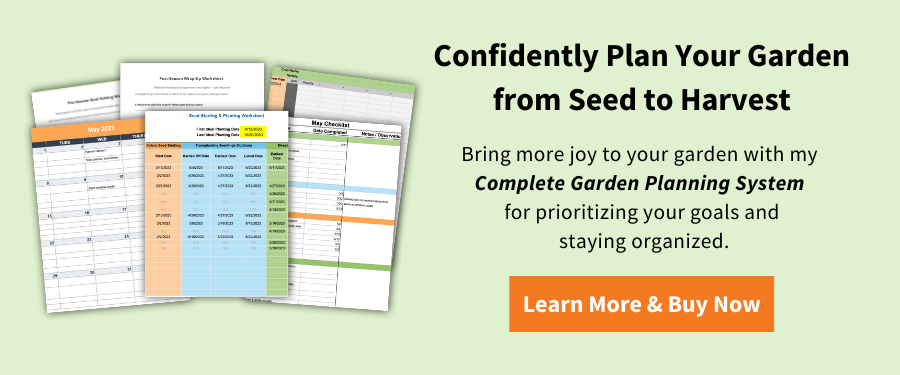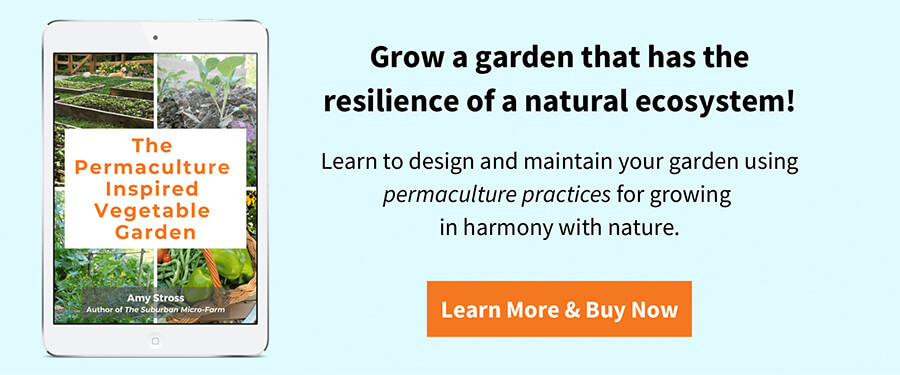Year-Round Gardening: It’s Easier Than You Think
Extend your harvest to all 12 months of the year with a year-round gardening plan. Are you ready to take your garden to the next level?


This page may contain affiliate links. Please read my disclosure for more info.
The idea of year-round gardening stirs up anxiety in many gardeners because it sounds like a lot of extra work. After all, isn’t it nice to take the winter off to rest, recuperate, and have time for other things? When I first learned about extending the harvest throughout the entire year, I was hesitant.
At the end of the official growing season, I’m so worn out that I look forward to the break! I believe the seasons ebb and flow for a reason, and that when the trees and soil are resting, so should I.
However, I was surprised to discover that year-round gardening does not have to mean a lot of extra work.
In fact, by staying in touch with my garden throughout each month and each season of the year, I was creating a deeper connection to nature and a deeper understanding of my garden’s ecosystem… all while getting continuous harvests!
5 Keys to Year-Round Gardening Success
I discovered that the key to year-round gardening success wasn’t working harder for more months of the year. Nope. Success came down to having a plan and being consistent with my actions. In fact, when I follow my own plan, I get to reap harvests throughout the off season without giving the garden much attention at all.
1: Have a Plan
Gardeners typically fall into two camps: They are either averse to any sort of planning and view it as a restriction of their own creative process; OR they are over-planners who don’t leave any space for ‘following their nose’ in the garden.
I find that seeking a balance of these two extremes usually results in the most rewarding outcomes.
That’s because having no plan means having no way to record essential garden tasks (When did I amend the soil?) and no way to troubleshoot the causes and effects that become either successes or failures. Memory is often a poor record.
Every gardener also has a different combination of climate, soil type, rainfall, sunlight and a whole slew of unique conditions that make up her experience. Following a rigid plan doesn’t account for these differences. It’s important to follow a plan that appoints you as the Head Scientist governing the experiments that lead to discovering the most appropriate practices for your situation.
Whichever camp you’re in, you’ll find the balance you need in these four garden planning tools.
Grow a garden that’s both productive and manageable with my Complete Garden Planning System, which includes practical tools for planning your season from seed to harvest.
2: Be Consistent: 15 Minutes a Day
When we get busy, our tendency is to put things off until we have a big chunk of time to devote to a task. But remember the tortoise? Slow and steady wins the race.
I like to take a 15-minute walk through my garden each day. Yes, even in the winter! It’s this consistency that keeps me connected to my garden even when I may not be getting a lot accomplished. It helps me to enjoy “being” in the garden, rather than always focusing on the “doing”.
The daily walk-through also has loads of direct benefits: You get to discover first-hand how your garden changes through the seasons: shifts in daylight, wet/dry cycles, weed cycles, pest cycles, fertility cycles. When you record what you notice using the tools mentioned above, your gardening success will soar.
3: Monthly Guides
I like to have an overview of what to expect each month of the year. I find it extremely helpful to have the answers to questions like:
- Which are the busiest, most demanding months in the garden?
- When will I have time to plan and get organized?
- What materials and equipment should I have on hand in preparation for each month?
- What harvests will I miss out on by taking a vacation during a certain month?
My monthly garden guides (below) show how the work in my garden flows throughout the year. Of course, every garden is unique, but it gives you an idea of how to think about a month in the life of your garden. (Tip: The four planning tools mentioned above will help you customize your own monthly guides.)
4: The 80/20 Rule
It’s easy to get mired in the gazillion little tasks that keep a garden ticking. This is often the biggest reason why some gardens fail. It can seem like we’re only making progress if we’re constantly buzzing around like a bee.
When we take a look at all of the possible tasks a gardener could do in a given month, which 20% of them could produce 80% of the results that lead to a successful, healthy garden?
Here’s an example of some tasks from my February Monthly Guide:
- Cut back dead plant matter and weed garden (weather permitting)
- Add soil amendments
- Mulch well
- Start seeds under grow lights
- Start seeds in a cold frame
- Build a new bed
Ideally, I complete many of these tasks in the fall (1,2,3,6). But let’s be honest. Sometimes the work doesn’t get done in the fall. So I add them to my monthly tasks early in the year to make sure they get checked off.
What if I had to choose 20% of the tasks above that absolutely have to get done to keep me on track? (That would be about 2 of these 6 tasks.)
In my opinion, I would focus on numbers 1 and 3: Cutting back dead plant matter and mulching. These tasks get the garden cleaned up (ready for planting) and ensure the soil is protected, which is at least 80% of being ready to have a bang-up season.
When you’re feeling overwhelmed, apply the 80/20 rule and see if it helps you focus your energy.


Shredded leaves make excellent mulch from a free resource.
5: Remember Why You Garden
Everyone gardens for different reasons, whether it’s to have a respite from the busy world, eat healthier, learn skills with a youngster, be more self-sufficient, connect with nature, get more exercise, or something else.
What is your ‘why’?
Remembering your answer will keep you motivated even when you’re tired, the heat is sweltering, and aphids have taken over.
Would you like to grow more food with less effort? Check out my mini guide, The Permaculture Inspired Vegetable Garden.
What to Plant Now: Monthly Garden Guides
If you’re interested in year-round gardening, my monthly garden guides will give you an overview of what it looks like to extend your gardening season over a full calendar year. Explore whether you can apply the 80/20 rule to your gardening so that you have year-round harvests (and satisfaction) without more effort. Here’s a look at the monthly guides as well as a few essential articles for success in every season of the year.
What to Plant Now: January
This is a time of reflection and planning, tidying, and organizing. Get organized while reaping passive harvests.
What to Plant Now: February
Get into the rhythm of the season with starting seeds and preparing beds. Passive harvests continue.
Get the February Garden Guide.
Also see:
What to Plant Now: March
The season is starting to speed up. Fruit trees and berry bushes are pruned. Seedlings grow up. A cold frame starts the season early.
Also see: Protect Cold Weather Crops with a Cold Frame
What to Plant Now: April
The garden is waking up. It’s time for sowing and transplanting outside as the weather allows. The ground is thawing and infrastructure projects can be tackled such as new compost bins or rain barrel systems.
Also see:
What to Plant Now: May
The season is upon us. Once-frozen beds need to be weeded and planted. Strawberries and asparagus pop up.
Also see: 5 Weeds You Want In Your Garden


Sugar snap peas: One of my favorite spring harvests!
What to Plant Now: June
Abundant rain means bright green gardens. Many fruits are harvested now. Check that beds are mulched for the hottest months ahead.
Also see: Mulching in the Permaculture Garden
What to Plant Now: July
Harvests start to come in and just as quickly, it’s time to plan for the fall/winter garden.
Also see:
What to Plant Now: August
Hot and humid days test our resolve. Irrigation is necessary. Harvests help to remember your ‘why’. Fall crops planted.
Also see: How to Have a Productive Fall Garden (in 5 Easy Steps)
What to Plant Now: September
In the waning sunlight, plants make a last-ditch effort to produce, while insects and wildlife prepare for winter. Still much to harvest.
Get the September Garden Guide.
Also see: Growing and Harvesting Beets Year-Round
What to Plant Now: October
Fall is here. Harvests continue, summer gardens are put to bed, while fall/winter gardens are tended to. Garlic is planted.
Also see: 9 Organic Soil Amendments for Growing Vegetables
What to Plant Now: November
Fall crops are harvested. Fruit trees and berry bushes are planted.
Get the November Garden Guide.
Also see: 5 Steps to Planting Fruit Trees
What to Plant Now: December
Fall crops are covered with row cover or cold frames to extend the harvest throughout the winter. Infrastructure projects can be tackled, weather and inspiration permitting. Or sit back and harvest from under a cold frame.
Get the December Garden Guide.
Also see: How to Prepare for the Winter Garden
Year-round gardening doesn’t have to be a lot of work. It’s simply a way to continue enjoying the garden and reaping the rewards year-round.
Have you experienced the joy of year-round gardening?
READ NEXT:
>>> Get my free 19-page Guide to Organic Soil Amendments for more ideas:









